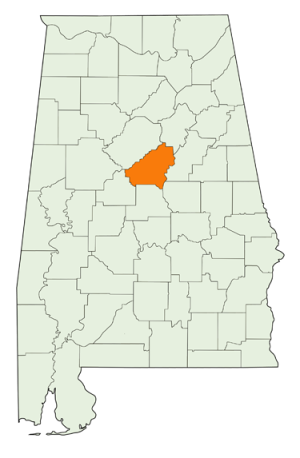Shelby County: Difference between revisions
No edit summary |
No edit summary |
||
| Line 4: | Line 4: | ||
It became part of the new [[State of Alabama]] upon its admission to the Union in December [[1819]]. The [[Shelby County Courthouse (1820)|first courthouse]], built in [[1820]], was located in the community of [[Shelbyville]], now within the corporate limits of [[Pelham]]. The county seat was moved to [[Columbiana|Columbia]] in [[1826]], with an old school serving as the courthouse. In [[1832]] Columbia was renamed "[[Columbiana]]" and remains the seat of Shelby County. | It became part of the new [[State of Alabama]] upon its admission to the Union in December [[1819]]. The [[Shelby County Courthouse (1820)|first courthouse]], built in [[1820]], was located in the community of [[Shelbyville]], now within the corporate limits of [[Pelham]]. The county seat was moved to [[Columbiana|Columbia]] in [[1826]], with an old school serving as the courthouse. In [[1832]] Columbia was renamed "[[Columbiana]]" and remains the seat of Shelby County. | ||
The | The 2010 U. S. Census enumeration of Shelby County's population is 195,085. Shelby County is ranked as the fastest growing county in Alabama and is one of the fastest growing counties in the country. | ||
==Geography== | ==Geography== | ||
Revision as of 16:18, 24 February 2011
Shelby County was created as a county of the Territory of Alabama by the Territorial General Assembly on February 7, 1818. Carved from the northern portion of Montgomery County, it included the area which has been further divided into Jefferson, Chilton, St Clair and Talladega counties. The county is named for Isaac Shelby, a hero of the Battle of King's Mountain in the Revolutionary War who was also the first governor of Kentucky.
It became part of the new State of Alabama upon its admission to the Union in December 1819. The first courthouse, built in 1820, was located in the community of Shelbyville, now within the corporate limits of Pelham. The county seat was moved to Columbia in 1826, with an old school serving as the courthouse. In 1832 Columbia was renamed "Columbiana" and remains the seat of Shelby County.
The 2010 U. S. Census enumeration of Shelby County's population is 195,085. Shelby County is ranked as the fastest growing county in Alabama and is one of the fastest growing counties in the country.
Geography
According to the U.S. Census Bureau, the county has a total area of 810 mi². 795 mi² of it is land and 15 mi² of it (1.83%) is water.
See List of Shelby County municipalities and List of Shelby County communities for settled places in the county.
History
Shelby County was created from area ceded to the Territory of Alabama by the Treaty of Fort Jackson in 1814. The first non-Indian homesteaders arrived shortly thereafter from Kentucky, South Carolina and Tennesee, settling predominantly in the Cahaba Valley near Shoal Creek. The first towns to spring up were Wilson's Hill (Montevallo) and Shelbyville (Pelham). Other towns followed in the Coosa Valley, including Bigs Springs (Harpersville) and Wilsonville.
The first court business was conducted at William Wallace's residence in Shelbyville. Following the admission of Alabama to the United States, Shelbyville was set as a the county seat and a courthouse was erected in 1820. The seat was moved to Columbia (Columbiana) in 1826 because of its more central location. The 1826 courthouse served until a new brick structure was erected in 1854. The present Shelby County Courthouse was constructed in 1906.
Demographics
As of the Census of 2000, there were 143,293 people, 54,631 households, and 40,590 families residing in the county. The population density was 180/mi². There were 59,302 housing units at an average density of 75/mi². The racial makeup of the county was 90% White, 7% Black or African American, and 1% Asian. 2% of the population were Hispanic or Latino of any race.
There were 54,631 households out of which 36.7% had children under the age of 18 living with them, 63.6% were married couples living together, 8.1% had a female householder with no husband present, and 25.7% were non-families. 21.7% of all households were made up of individuals and 5.2% had someone living alone who was 65 years of age or older. The average household size was 2.59 and the average family size was 3.04.
In the county the population was spread out with 26.3% under the age of 18, 8.2% from 18 to 24, 33.7% from 25 to 44, 23.4% from 45 to 64, and 8.5% who were 65 years of age or older. The median age was 35 years. For every 100 females there were 96.20 males. For every 100 females age 18 and over, there were 92.6 males.
The median income for a household in the county was $55,440, and the median income for a family was $64,105. Males had a median income of $45,798 versus $31,242 for females. The per capita income for the county was $27,176. About 4.60% of families and 6.30% of the population were below the poverty line, including 7.10% of those under age 18 and 8.20% of those age 65 or over.
See also
References
- Galloway, Eloise (1937) History of Shelby County. Montevallo, Alabama: History Department, Alabama College
- Wright, A. J. (June 4, 2004) "Pelham -- More history than you think!" Pelham City News. Vol. 10, No. 5
- "Shelby County, Alabama." Wikipedia, The Free Encyclopedia. 14 Oct 2006, 01:39 UTC. Wikimedia Foundation, Inc. 17 Nov 2006 [1].
- Lewis, Herbert J. (October 29, 2008) "Shelby County". Encyclopedia of Alabama - accessed March 12, 2009
External links
- Shelby County Government
- Shelby County Web Portal
- Shelby County Wiki (covering Shelby Counties across the US)
| Shelby County | |
|---|---|
| Topics | |
| Cities |
Alabaster | Calera | Chelsea | Columbiana (seat) | Harpersville | Helena | Indian Springs Village | Montevallo | Pelham | Vincent | Westover | Wilsonville | Wilton |

